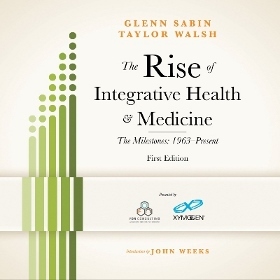The Absurd Economics of Nutrition and Exercise

It’s fair to say that, to a large extent, America has long fostered a culture and environment conducive to physical inactivity and nutritional-based disease.
With today’s prevailing science clearly showing that teaching and practicing lifestyle medicine significantly decreases the top chronic health conditions plaguing society—i.e., diabetes, obesity, heart disease and certain cancers—moving more firmly in this healthier, logical direction would subsequently trigger a vast increase in human productivity and output, thus creating a major boon to both population health and our national treasury.
Unfortunately, our medical industry still incentivizes diagnostics and procedures over actual “health creation” though the latter is clearly in the best interest of the American health consumer.
With respect to preventing, treating and controlling most chronic diseases, the growing literature base supporting the “three-legged stool” of nutrition, physical activity and stress reduction is at this point, beyond reproach. So exactly why then are these low cost, low tech, powerful clinical and educational interventions largely missing, or at best, minimally covered within the core medical school curriculum?
Teaching Nutrition and Exercise in Medical School
I recently came across an incredible white paper called Teaching Nutrition and Physical Activity in Medical School: Training Doctors for Prevention-Oriented Care. Born from a 2013 public forum centering on the same topic, the document was developed by the Bipartisan Policy Center’s Nutrition and Physical Activity Initiative in association with the American College of Sports Medicine and The Alliance for a Healthier Generation.
Framing the current chronic disease epidemic as “the most challenging and costly public health threat confronting America today”, this report plainly communicates how naturally well-positioned health professionals are to help turn the tide … if only better equipped with quality education and training.
Following are 9 key recommendations the authors found for improving medical education and training in the areas of nutrition and exercise:
1. Develop and implement a standard nutrition and physical exercise curricula.
2. Include more nutrition and physical education content in licensing and certification exams.
3. Increase nutrition and physical activity requirements for residency and continuing education programs.
4. Expand board-accredited advanced training programs to create a cadre of experts in nutrition and physical activity who can teach health professionals.
5. Provide federal and state support for reforms in medical education and health care delivery that can help providers better meet patient needs with respect to nutrition, physical activity, and other lifestyle factors.
6. Recognize and reward innovation to drive continued funding and administrative support for reform efforts that are already underway.
7. Provide reimbursement for health services that target lifestyle factors such as nutrition and exercise.
8. Extend improvements in nutrition and physical education activity to other health professional schools.
9. Increase and broaden awareness of the need for change in medical education
Enjoying this article? Subscribe and get our latest, delivered straight to your inbox.
The Bipartisan Policy Center and co-sponsors of this white paper did a terrific job pulling together these key recommendations. Certainly, implementing these ideas would go far in establishing a new generation of health professionals who, armed with the basic tenets of lifestyle medicine, could effectively promote and advance health creation; thereby driving down the exorbitant cost of chronic disease over time. However, there’s a glaring problem. Let’s take another look at #7: Provide reimbursement for health services targeting lifestyle factors such as nutrition and exercise. This should be listed as #1, because…
It Doesn’t Pay For Providers to Deliver Nutrition and Exercise Counseling—It Costs. (click to tweet)
The fact that today’s inherently flawed economic system doesn’t properly compensate third party payer system providers for delivering critical nutrition and exercise counseling services is, in a word, absurd. Until this key issue is corrected, the high value– possibly transformative– upside potential thereof will never be fully realized.
Sure, group medical appointments can be considered when there’s sufficient patient volume. It’s also helpful that accountable care organizations are nominally incented to incorporate the tenets of lifestyle medicine for reducing hospital readmissions and ensuring surgical bundle reimbursements. Check out how these ACOs are providing lifestyle medicine today.
However, it’s a totally different story for primary care and family medicine physicians trying to keep pace on the grueling treadmill of seeing five or more patients per hour for relatively paltry reimbursements. The reality is that time is money and who within a third party payer model (including Medicare) has requisite time to adequately teach their patients the importance of nutrition and physical activity? Why bother?
How can we shorten medical school programs from four to three years while simultaneously adding an expanded curriculum covering nutrition and physical activity?
I champion direct-pay, concierge and hybrid practice models for integrative, functional and lifestyle medicine trained physicians (including NDs and PAs and DCs), assuming community demographics support. Currently, practitioners of this model are paid an honest sum to deliver medicine focusing on lifestyle change. Even private practitioners working within concierge franchises like MDVIP and MedLion have ample opportunity to get paid for teaching the basics of behavioral change.
Clinical nutritionist or registered dietician consults are often bundled (read: subsidized) during inpatient hospitalizations. Outpatient services are typically covered only for type 2 diabetes patients and for those with certain types of heart disease. But if you’re a cancer patient, forget about it! Unless you have cachexia or it’s subsidized as part of a hospital bundle, your visit with a nutritionist or dietician won’t get covered by either Medicare or a third-party payer. The economic incentive to promote wellness, i.e., nutrition and physical activity, is simply just not there.
Build the Financial Foundation First
Bottom line: Until providers working within insurance and Medicare models are adequately compensated to deliver these key services, the transformation to an environment fostering fundamentally vital preventive and lifestyle medicine will never take hold.
About FON
FON is a leading integrative health and medicine business development and strategy consulting firm. FON specializes in custom solutions for growing patient volume, developing programs, and increasing product sales. Our practical business models are driven by innovative marketing, clear messaging, and customer engagement via branded storytelling.
Contact us today to schedule a complimentary 30-minute consultation to discuss your business development or personal brand needs.

Read Glenn’s story.

